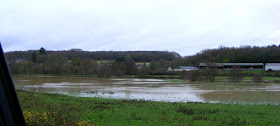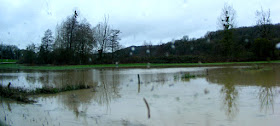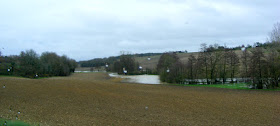On 15 December we drove through the Aigronne Valley, one of the tributaries of the Claise, to discover it was very flooded. It shouldn't have been a surprise -- after an exceptionally hot dry summer, much of our normally evenly distributed rainfall fell in a period of a couple of months at the end of the year. It finally brought us up to our normal annual average rainfall, but a lot of it sat around on the fields for days and weeks. Newly planted wheat seeds rotted in the ground and farmers couldn't get on to their land to work it.
************************************************
For details of our private guided tours of chateaux, gardens, wineries, markets and more please visit the Loire Valley Time Travel website. We would be delighted to design a tour for you.
We are also on Instagram, so check us out to see a regularly updated selection of our very best photos.
We are also on Instagram, so check us out to see a regularly updated selection of our very best photos.





6 comments:
Rotting seed? That is their problem... they shouldn't have ploughed up and planted the hay meadows that form the flood plain.... it isn't called a flood plain for nothing.
Also they've compressed the soil by bringing heavy equipment onto it... and destroying earthworms, etcetera by application of pesticides and manure and slurry that's full of excess overdosed worming medicine....
The field that I call "Lake Gatault"... the one bordered by the ditch full of Fritillaria meleagris... and the next two towards the road bridge are so concave it is visible to the naked eye when dry!
They were all full of cattle when we bought in 2003...
Additionally, they all had fences bordering the road... and at least one pair of Stonechats per field.
I think farmers had wheat seeds rot in perfectly ordinary fields. The comment about that came from a farmer over near Bossay, not one along the Aigronne.
It used to flood regularly there when we we there! As Tim said flood plain!
Yes, they have... and that is because they now insist on sowing winter wheat... no, my comment was a response to the idiotic use of water meadows as growing land!
Yes, the "flatlands" have actually had standing water since the ground recovered from the dustpan state... again, modern techniques are heavily compacting the soil... continuous shallow ploughing when you are using heavy equipment creates a perfect tilth quite rapidly... but you compact the soil 6" down... destroy the worms that can create drainage through the compaction and... ponding in heavy rain! Especially on the far more claybound soil up there.
Again though, ploughing techniques up there are also creating many more hollows than previous....
M.Salais, up at Grandmont, uses a different technique... on the field between the bridge and the rotting poplar plantation, he ploughs from the two edges to the centre of the field, rather than going back and forth parallel the road towards the river... he is the only one I have seen do this... but there is never more than the tiniest, short-lived pond in that field... nor does he have a high edge at the river side!
M. Salais sounds interesting. I photographed some impressive water filled wheel ruts yesterday in a field on the heights above Abilly. And I was just saying to Simon the other day that farmers are going to have to drop winter wheat. I don't know what they replace it with, or when a suitable time to plant would be. Nothing is reliable any more. They can't just switch to spring wheat, as the land is often still too wet, and they'll risk the same dry spell just when the ears should be plumping that you tend to get with winter wheat these days.
Yes, the ploughing up of flood meadows is just dumb.
Post a Comment